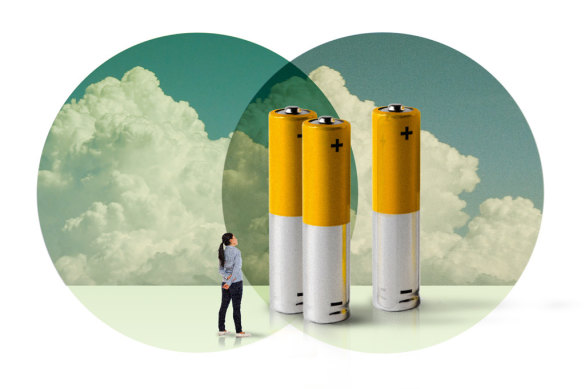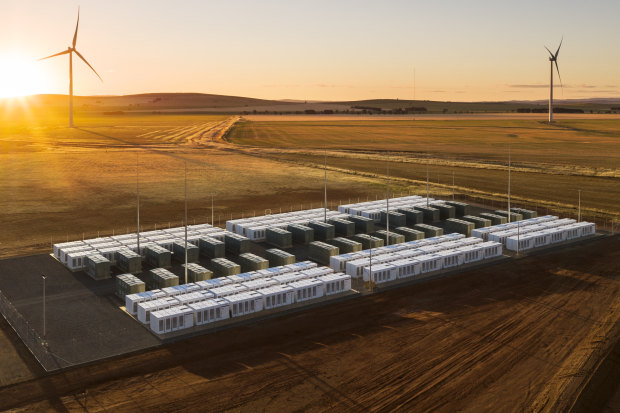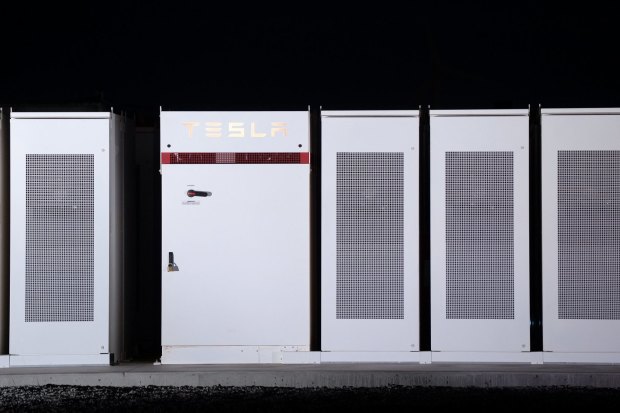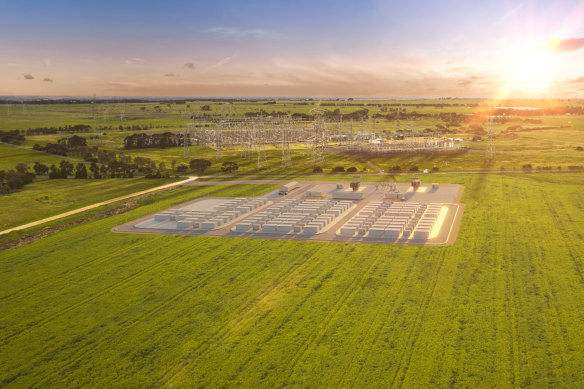Explainer
- Explainer
- Future Power
What are big batteries and how could they reshape the electricity grid?
Australia’s first “big” battery worked so well there are now more than 40 built or planned across the country. How do these batteries work?
By Nick O'Malley and Mike Foley
It’s only a little over three years ago that Elon Musk boasted he could help South Australia solve a looming energy crisis by installing a big battery in less than 100 days for under $100 million.
At the time the plan was met with scepticism by some, outright derision by others. Then-treasurer Scott Morrison compared the proposal with the Big Banana: “I mean, honestly, by all means have the world’s biggest battery, have the world’s biggest banana, have the world’s biggest prawn like we have on the roadsides around the country, but that is not solving the problem.”
Perhaps the scepticism was understandable. Before “big” batteries – batteries designed to serve the grid rather than a home or car – came along most people associated grid-scale power works as projects that demanded years of planning, vast engineering and billions rather than millions of dollars.
It didn’t help that the proposal was born, in part, of a bet made over Twitter between a pair of media-friendly billionaire tech bros, the Australian Mike Cannon-Brookes and Musk, who not long after the announcement shot one of his Tesla cars into space atop one of his SpaceX rockets.
But as it turned out, the big battery – more properly known as the Hornsdale Power Reserve – was built in just two months in 2017 for around $90 million, and it has served its purpose so well since that big batteries are now under construction across the country.
“I think that was a defining moment. I think it made this technology real for people,” says Dr Alex Wonhas, the chief engineering office for the Australian Energy Market Operator. According to the AEMO, since that battery was completed there has been a rush of new developments.
At the time of its construction the Hornsdale big battery, built by Tesla for the renewable energy company Neoen, had a capacity of 100 megawatts, though it has since been expanded to 150 megawatts. Today, there are more than 40 big batteries either completed or planned with a total capacity of more than 7000 megawatts across Australia.
According to Wonhas, the Australian energy system is being transformed at twice the rate of comparable systems overseas, and big batteries have proven themselves to be crucial to the transformation.
But how do these batteries work? What are they for? And how might they reshape the electricity grid itself?

Artwork: Matthew Absalom-WongCredit:
Why the need for big batteries at all?
Historically, Australia’s energy system has been well served by vast coal-fired power plants that provided cheap and reliable energy, all the while pumping out about a third of the nation’s total greenhouse gas emissions. Across the five eastern states that make up what is known as the National Energy Market, coal still provides around 60 per cent of the power. Crucially, the fleet of vast old plants also provide what’s known as frequency control and inertia, services the grid needs to maintain its stability.
But the coal-fired power plant fleet is rapidly ageing.
The average life of a coal-powered plant is around 30 years, although they can operate for up to 50. Around three-quarters of Australia’s plants are now operating beyond their ideal design life. AGL has already made public the target closure dates for its three large thermal-coal plants: Liddell by 2023, Bayswater by 2035 and Loy Yang A by 2048.
As the fleet ages, maintenance demands increase and shutdowns become more common, driving up the cost of the power it produces.
But as power companies have begun to consider how they might replace the coal plants over recent years, the world has been rapidly changing. Concerns about climate change have intensified and renewable energy technologies, particularly wind and solar, have plummeted in cost.
In 2020, the International Energy Agency – an outfit long criticised for underestimating the potential of renewable energy – wrote in its key annual outlook report that solar projects with access to reasonably priced start-up capital were now providing “the cheapest electricity in history”.
The economics had already become clear to Australian households, which have been sticking photovoltaic panels on their homes faster than any other nation on earth. The Australian Renewable Energy Agency (ARENA) estimates that between one in five and one in four homes in Australia now has solar panels, and demand for them is yet to slow.

The Hornsdale mega-battery in South Australia was the biggest in the world when it was built.
Large-scale wind and solar farms are on the rise, too. At the end of 2018, large-scale solar farms in Australia generated more than 1824 megawatts, while in 2019 a further 61 large-scale solar farms were added, according to ARENA.
This surge in renewables has been causing headaches for old-school power generators and retailers, for regulators and for governments seeking to set policy to make sure the grid remains viable and stable.
To understand why you have to know a little about how Australia’s centralised and fossil-fuel-intensive electricity market works.
While households pay a consistent amount for the electricity they use, the price of electricity fluctuates throughout the day on wholesale markets responding to supply and demand.
This has seen companies selling solar power during the day undercut the prices of the major retailers heavily invested in coal power, driving down the overall cost of electricity, and the profits of the old power giants.
In January, Energy Security Board chairwoman Kerry Schott warned that low wholesale energy prices were reducing the incentive for coal- and gas-powered electricity generators to remain on-line at all times, and in the long run could even bring their retirement forward.
The problem is that while renewables are driving down prices, and rendering the huge old plants less economically viable, they cannot provide all the electricity we need – especially when wind is not blowing and sun not shining – the sort of power that used to referred to as “baseload” and is now more commonly described as “dispatchable”.
Until now, we have relied on gas plants and hydroelectricity to provide the quick bursts of power needed to smooth out the grid and back up the coal fleet but the plummeting costs of big batteries is changing the equation.

The power packs that make up the Hornsdale plant, pictured in 2017.Credit: Carla Gottgens
What’s the appeal of big batteries?
By the time Musk bet Cannon-Brookes in 2017 that he could build the Hornsdale power plant in record time at minimal expense, he had a better understanding than most of how cheap the technology had become. Months earlier, Musk had begun the mass production of batteries for Tesla vehicles at his so-called Gigafactory 1 in Nevada.
As Wonhas points out, a key attribute of big batteries is their simplicity. A grid-scale battery consists of rows of domestic or vehicle lithium-ion batteries installed together. As the market for home batteries and electric vehicles takes off around the world, more factories come online to supply them, forcing down prices further.
In January, the international energy consultancy Wood Mackenzie published a report predicting that battery costs around the world would fall another 30 per cent by 2025.
“Manufacturers will continue to innovate and produce ... components that help reduce labour costs, and installation crews are implementing more efficient labour practices as they gain more experience on job sites,” says Wood Mackenzie senior analyst Mitalee Gupta. “Competitive markets will drive system efficiencies, product standardisation and cheaper batteries as we progress towards 2025.”
According to the report, costs in Australia will fall by 34 per cent.
As costs fall, the ambitions of new players in the energy market increase. In January, CEP Energy announced it would build a 1200-megawatt-capacity battery in the Hunter Valley, taking advantage of the grid infrastructure already in place to connect ageing thermal coal power plants.
CEP Energy will source much of its power from solar farms placed on warehouse and industrial rooftops under a deal it signed last year with the commercial real-estate giant Pelligra, which has 10 million square metres of rooftops around the country under its control. The CEP battery could be up to 12 times the size of the Hornsdale big battery, which was the largest in the world when it was completed.
Besides their falling cost and ease of installation, the versatility of big batteries is driving their uptake. Wonhas refers to them as the “Swiss Army knife” of grid infrastructure. They can be built in conjunction with solar or wind farms or simply store power from the grid. They can supply household power as well as grid stabilisation services.
One independent report found that by September last year the Hornsdale battery had saved South Australian consumers $150 million.

An illustration of the new big battery to be built near Geelong.
How might these batteries change the grid?
The rapid uptake in the use of big batteries could soon change the shape of the grid itself. Bruce Mountain, who is the director of the Victorian Energy Policy Centre, a Victoria University think tank, says the falling cost of grid-scale batteries is changing the fundamental principles of the electricity grid and the multi-billion-dollar transmission lines holding it together.
“The case to build a whole lot of energy generation in one state and ship it to another isn’t there any more,” Mountain says.
Until now, expensive, interstate transmission lines have been built across vast distances to link large-scale coal and gas generators with power-hungry capital cities. These costly power lines were needed primarily to facilitate the market and balance out the big differences in cost of production between different power generators – for example, the cheap, brown coal power from Victoria’s La Trobe Valley compared to more expensive thermal coal in NSW and Queensland, or gas-fired power in South Australia.
But renewable power costs the same wherever it is generated. “Big interstate links provide a spare source of supply but you can now meet that cheaply through battery storage located very close to where the power generation is located,” Mountain says.
He says batteries are now so cheap they are out-competing gas peaking plants, changing the way operators and regulators view future infrastructure needs.
Batteries can be placed at strategic sites around the grid, to inject bursts of power to fill gaps in dispatchable supply, meaning that the nation’s existing power supply can be used more efficiently to serve greater demand. One example is the 300-megawatt battery to be completed in Geelong later this year that will have the capacity to service the average energy needs of 650,000 households for an hour, but which will also stand ready to pump power into the grid in the event of a shortfall, making sharing between NSW and Victoria more efficient.
Big batteries can also remove the need for hydro dams – which can only be built where rivers and geography allow – and require big costly transmission lines to move their power to where it is most needed.
“We can say for sure now that battery storage is much cheaper than transmission lines and that case is only likely to grow,” says Mountain.
The rapid advance of batteries could have implications for Tasmania’s bid to become the Battery of the Nation by exporting power from its hydroelectric projects to the mainland via submarine cables.
“Tasmania wants to become an exporter to obtain more value from their hydro-electric system. But I think Victoria would think twice about helping them with the costs when it can choose cheaper battery alternatives to bolster their supply,” says Mountain.
A study by the Victorian Energy Policy Centre last year analysed the costs of the 1500-megawatt Battery of the Nation proposal. At present, the estimated cost is around $1.5 billion for hydro-electric work and $3 billion for the transmission line. Mountain’s study found that 1500 megawatts of battery capacity, with six hours of storage capacity, would be cheaper than the transmission line alone.
Other transmission link proposals are under consideration, each of which could cost more than $2 billion.
Mountain believes battery technology could even disrupt the Snowy 2.0 pumped-hydro project. This is a $5-billion plan to pump water 27 kilometres between two Snowy Mountain dams to increase the Snowy scheme’s current 4000 megawatt output by 50 per cent, a centrepiece of the federal government’s plan to ensure there is enough reliable and renewable power in the market to drive down prices.
If the government’s goal is to promote the cheapest solution, says Mountain, “batteries will almost certainly win”.
Also in the Future Power series …
With a worldwide energy revolution under way, where is Australia up to? In this six-part series, we’ve explored some of the issues in green (and perhaps not so green) energy and reviewing how new technologies – and the issues that come with them – are set to shape up in 2021 and beyond.
What’s a “just transition” and can you switch to green energy without sacking coal workers? Science says the switch to renewables needs to be fast while workers on the ground say it should also be fair. We ask, how did Germany do it? And could Australia really have a “just transition” too?
What is the role of gas in a green economy? We explain why the Australian government wants more gas and we ask, how clean is it actually? So what, then, is the future of gas in Australia?
What is carbon capture and storage (and does it work)? We unpack “CCS” and variations on it. What are the hopes for them? And why are they so devilishly hard to pull off?
How is Australia travelling with the switch to electric cars? Given electric cars will become a part of the power grid one day, why is Australia stuck in the slow lane on uptake while other countries zoom ahead?
Hype or holy grail: What’s driving the hydrogen rush? What is green hydrogen? How could it help the environment? And what’s its future in Australia?
Let us explain
If you'd like some expert background on an issue or a news event, drop us a line at explainers@smh.com.au or explainers@theage.com.au. Read more explainers here.